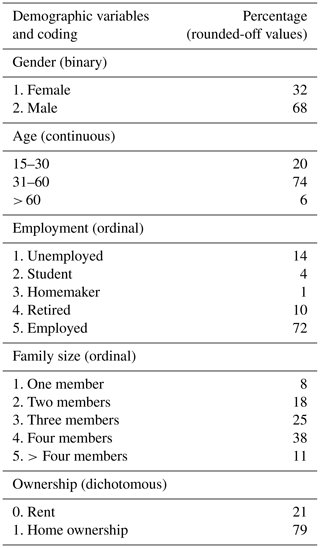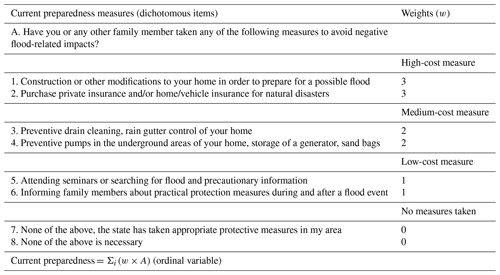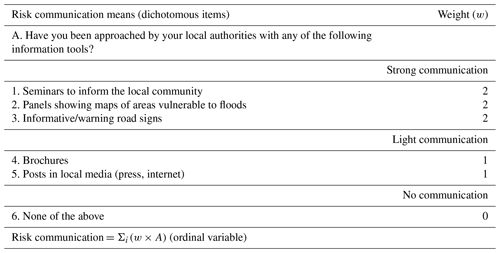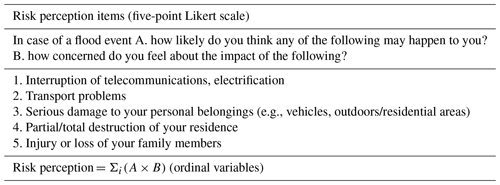the Creative Commons Attribution 4.0 License.
the Creative Commons Attribution 4.0 License.
How awareness and confidence affect flood-risk precautionary behavior of Greek citizens: the role of perceptual and emotional mechanisms
Vassiliki Kotroni
Kostas Lagouvardos
Giorgos Papagiannakis
This study examines the mechanisms of flood-risk precautionary behavior among Greek citizens. To that end, we specify and test a mediation model in which awareness-raising factors and confidence attitudes influence the citizens' current flood preparedness and preparedness intention through perceptual and emotional processes. Raw data were obtained via an online survey that received 1855 responses. Causal relations were tested by means of structural equation modeling (SEM). Overall, results indicate that risk perception and worry are significant drivers of preparedness intention. In particular, they act as mediating variables, explaining how flood experience, access to more risk information, vulnerability awareness, and trust in authorities affect citizens' intention to invest in precautionary measures. Especially trust was found to have a negative effect on worry, leading to lower preparedness levels. Worry was also found to have a significant role in explaining the current preparedness levels. Interestingly, citizens who had already undertaken precautionary measures in the past appear to be more willing to invest in more measures. Implications for improving flood-risk management in Greece are discussed.
- Article
(1457 KB) -
Supplement
(234 KB) - BibTeX
- EndNote
Floods are among the most costly and life-threatening weather-related hazards, causing serious concerns among societies worldwide (Barredo, 2007). Moreover, the observed increase in European flood losses is largely due to the growing exposure of assets (Barredo, 2009). Emphasis is therefore given to the need to address societal causes of the increasing flood risk (Treby et al., 2006). During the last 2 decades, flood-risk management has undergone a gradual shift, moving from the investment in costly structural measures to nonstructural measures and related policies that promote the enhancement of communities' resilience to floods (Nye et al., 2011; Cardona et al., 2012; Rambonilaza et al., 2016). In this effort, public authorities and citizens share the responsibility for the consequences of flooding (Lave and Lave, 1991; Fatti and Patel, 2013). Given a basic level of protection by the managing authorities, individuals' decisions may affect their exposure to flood risk and effectively contribute to the reduction of material losses (Kron, 2005).
Individual precautionary behavior is a crucial element of a community's preparedness against flood risk. As reported by the United Nations International Strategy for Disaster Reduction (UN/ISDR, 2009), individual preparedness contributes to the effective anticipation, response, and recovery from the effects of disasters. Kreibich and Thieken (2008) showed that flood losses can be considerably reduced when private precautionary measures are undertaken. Therefore, a better understanding of the determinants of individual preparedness can help policy makers to improve communication and flood-risk management.
This article focuses on flood-risk precautionary behaviors of Greek citizens. The general objective is to survey and better understand the factors that drive individual flood precautionary behavior in an area that has been poorly addressed. Only recently did Diakakis et al. (2018) survey the flood-risk perception of citizens of Attica, the region of Greece most affected by floods, and provided evidence of low levels of trust in the authorities, low levels of knowledge of protection actions and awareness regarding floods, and low levels of preparedness. An earlier study on individual emergency response to flash floods in Attica (Papagiannaki et al., 2017) showed that precautionary behavior is associated with deeper feelings of worry or fear for flood hazard. Factors that can influence flood-risk perception and precautionary behavior have been the subject of surveys for different regions, with the aim of highlighting the most important ones. The articles by Bubeck et al. (2012) and Kellens et al. (2013) provide overviews of empirical findings of current literature showing that the array of flood preparedness drivers remain controversial. Thus far, however, the underlying causes of flood precautionary behavior have not been sufficiently studied. This study therefore investigates within a structured context the mechanisms driving precautionary behavior, focusing on perceptual and emotional processes. Practical implications of the findings are related to the potential to inform on tailored approaches to risk management efforts in a region that is characterized by inadequate flood preparedness and risk communication.
2.1 Factors influencing flood preparedness
A growing number of research projects investigate the extent to which citizens undertake flood mitigation measures and the factors that drive precautionary behavior, which can be grouped into two meaningful categories. The first category includes factors that may influence the level of citizens' awareness of flood-related issues. According to the review of current empirical literature conducted by Bubeck et al. (2012), personal flood experience and risk communication locally are among the main awareness-raising factors that influence the level of preparedness. Specifically, except for Takao et al. (2004) and Thieken et al. (2007), all the studies examined by Bubeck et al. (2012) show that negative flood experience is statistically related to higher degrees of preparedness. Moreover, Grothmann and Reusswig (2006) find a statistically significant relationship between the severity of damage suffered and flood mitigation behavior. The authors also argue that effective risk communication can motivate people to step up their efforts to prevent damage, especially those that were never directly affected by a flood. As Thieken et al. (2006) denote, flood hazards and mitigation strategies should be better communicated to encourage precautionary measures. The SREX IPCC report (Cardona et al., 2012) emphasizes the critical value of risk communication for effective adaptation and disaster risk management. Despite, however, the arguments about the importance of communicating risk to citizens in order to alert them, the impact of relevant actions on precautionary behavior has not been adequately investigated. Neither has the individual awareness of vulnerability – particularly the exposure-related vulnerability – examined for the impact on precautionary behavior. However, researchers agree that the impact magnitude of floods on humans and their property depends strongly on the level of vulnerability due to exposure to flood hazard (Cardona et al., 2012).
The second category of potential drivers of flood preparedness includes factors related to one's confidence in the management authorities' coping capacity and in their own personal judgment and coping capacity. Feelings of trust in authorities have been found to discourage precautionary behavior (Terpstra, 2011) and to promote passive behavior (Poussin et al., 2014). Wachinger et al. (2013) argue that the lack of trust is likely to affect people who believe there is no other choice. Thieken et al. (2007) interviewed flood-affected inhabitants of Germany and concluded that knowledge about self-protection could positively influence the extent and type of private precautions and the ability of residents to perform mitigation measures.
The role of demographic variables has also been investigated, although the results are particularly contradictory on the extent to which such factors have a significant impact on precautionary behavior. Demographics are occasionally found to have only a marginal effect on preparedness (Terpstra and Lindell, 2013; Wachinger et al., 2013). According to the review of Kellens et al. (2011), homeowners appear to be more worried and better prepared, employment and income are associated with preparedness intention, and people that live in a less urbanized area appear to perceive higher flood risk (Scolobig et al., 2012).
2.2 The role of perceptual and emotional factors
In addition to the aforementioned variables, behavioral studies suggest that perceptual and emotional factors may also influence individual decision-making and attitude change. The perception of risk is shaped by the conceptual understanding of the expected threat (Glatron and Beck, 2008). According to the protection motivation theory (PMT) introduced by Rogers (1975, 1983) in the field of psychology, if the individual does not appraise an event as severe or likely to occur, no protection motivation, and thus no behavioral change, is expected. The studies of Botzen et al. (2009) and Terpstra (2011) suggest that risk perception may influence preparedness intention, even though their results were based on different constructs of risk perception.
It is nevertheless clear that risk perception alone is not a sufficient condition for the promotion of precautionary behavior. For example, as Kellens et al. (2013) argue, flood risk may be differently perceived as a result of the level of human exposure to floods. Kreibich and Thieken (2008) found a positive correlation between risk perception and the adoption of precautionary measures among people who were affected by a recent flood event in their area. Wachinger et al. (2013) in their review of studies on risk perception in connection with natural hazards, show evidence that if experience arises from low-severity events, it may have a negative impact on precautionary behavior due to overestimation of individual coping capacity. This is enhanced by the findings of Ruin et al. (2007), which show that a person without flood experience tends to underestimate danger. In addition, risk communication may influence risk perception, especially when there is a lack of personal flood experience (Wachinger et al., 2013). In this case, effective communication of risk may help people to better perceive the potential negative consequences. Conversely, feelings of security associated with trust in authorities may be associated with reduced risk perception (Poussin et al., 2014). According to Wachinger et al. (2013), trust is even more important in shaping risk perception if individual knowledge about the hazard is low. Apart from the perceptual factors, prior empirical work shows that emotions, such as worry and fear of floods, are also likely to trigger precautionary behavior (Miceli et al., 2008; Bradford et al., 2012). As Raaijmakers et al. (2008) point out, the need for risk reduction is determined by the level of worry about the risk, as long as the individual does not ignore the risk.
2.3 Aims of the study
Drawing on the above, the present study adopts an integrated approach to examine perceptual and emotional mechanisms of flood-risk precautionary behaviors in the social context of Greece. The aim of the study is to explore and understand within a structured context the underlying causes of individual preparedness and to offer new evidence for the implementation of awareness-raising campaigns targeted at citizens to promote individual precautionary behavior. To that end, we first specify a research model following the hypothesis that risk perception and feelings of worry mediate the effects of key predictors on flood precautionary behavior. The examined key predictors are related to awareness-raising factors and confidence-related attitudes. As previously discussed, these factors have been identified either empirically or theoretically as potential preparedness stimuli. The extant literature, however, has not yet simultaneously addressed how perceptual and emotional mechanisms link these factors with precautionary behaviors. Thus, significant unmodeled relationships may have been omitted, which may result in either a partial understanding of the entire process or even misleading statistical findings.
Secondly, in the context of the research model we further investigate the relationship between two sides of precautionary behavior, specifically of preparedness at the moment of the survey and preparedness intention. As the need for increased resilience of societies to floods is ongoing, continuous individual preparedness and renewal of protection measures are also required. Therefore, the objective is to examine whether precautionary behavior is discouraged when the person has already adopted some risk management measures.
To collect relevant data, we utilized an original internet-based survey targeting Greek citizens. The questionnaire was launched by the most trusted Greek meteorological site, which is also among the five most visited websites of general interest in Greece. A significant number of valid responses (1855) was received. Structural equation modeling is applied to examine the derived hypotheses.
2.4 Model specification and hypotheses
The conceptual framework of the present model of flood-risk precautionary behavior – hereinafter FPB – has been built upon existing theories of individual attitude change, namely the initial PMT (protection motivation theory) and its revised version (Rogers, 1975, 1983). In PMT, cognitive processes facilitate fear-appeal components to stimulate behavioral change. It has been used by Bubeck et al. (2013), Grothmann and Reusswig (2006), and Zaalberg et al. (2009) to examine human attitudes against flood risk. The focus of PMT is on the cognitive appraisal of the risk rather than emotions; protection motivation is mainly due to cognitive processes. Poussin et al. (2014) applied an extended framework of PMT with additional components that literature has identified as potential predictors of flood damage mitigation behavior. Within this model, exogenous variables, such as flood experience and the provision of financial incentives, are examined for their direct effect on preparedness. The FPB hypothetical model – illustrated in Fig. 1 – extends alternative aspects of the mechanisms of self-protection behavior. It examines whether mechanisms that encompass both cognitive and emotional processes facilitate or discourage a person's precautionary behavior depending on the level of awareness and the confidence attitude this person has. More specifically, risk perception and feelings of worry are considered to act as mediators, and thus to filter the effects of individual awareness and confidence on current preparedness and preparedness intention. A mediation process, X–M–Y, occurs when the influence of a given predictor variable X to a given response variable Y is carried through a third variable (mediator, M). Therefore, Fig. 1 illustrates our conceptualization of the awareness and trust – perception and emotion – precautionary behaviors model, from a mediating process perspective.
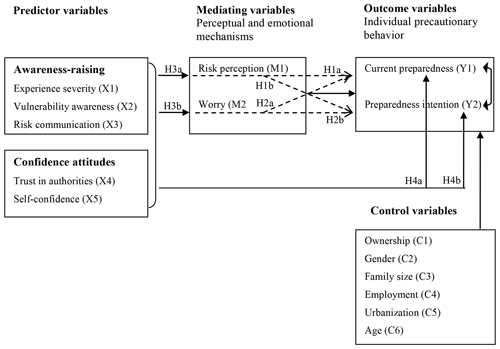
Figure 1Model of flood-risk precautionary behavior (FPB) and hypotheses. (1) Dashed and straight arrows depict predicted mediation (indirect) and direct effects, respectively. (2) The two-way arrow between Y1 and Y2 indicates that these variables may be correlated without any assumed direct relationship.
Table 1Definitions of FPB model variables and indicative references.
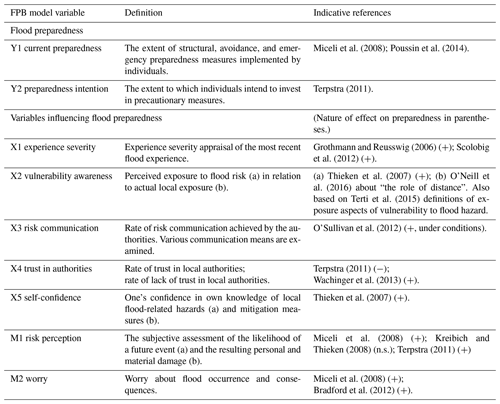
The signs +, −, and “n.s.” signify positive, negative, or not significant effect on flood preparedness (the extent of measures taken or preparedness intention), respectively.
Table 1 introduces the constructs, their definitions, and indicative references that provide empirical or theoretical evidence of a positive, negative, or insignificant effect of exogenous variables on flood preparedness. In accordance with the definitions of the EU Civil Protection and Humanitarian Aid Operations (EC, 2019), preparedness refers to measures taken by individuals to prepare for and mitigate the impact of flood events. Current preparedness refers to initiatives already taken, while preparedness intention refers to the intention of individuals to invest in measures in the near future.
On the basis of the above specifications, the FPB model hypotheses tested (Fig. 1) are the following:
-
H1a. Risk perception (M1) mediates (dashed array) the effects of the predictor variables (X1–X5) on current preparedness (Y1).
-
H1b. Risk perception (M1) mediates (dashed array) the effects of the predictor variables (X1–X5) on preparedness intention (Y2).
-
H2a. Worry (M2) mediates (dashed array) the effects of the predictor variables (X1–X5) on current preparedness (Y1).
-
H2b. Worry (M2) mediates (dashed array) the effects of the predictor variables (X1–X5) on preparedness intention (Y2).
-
H3a–H3b. Awareness and confidence (X1–X5) have direct effects (continuous arrows) on risk perception (H3a) and worry (H3b).
-
H4a–H4b. Awareness and confidence (X1–X5) have direct effects (continuous arrows) on current preparedness (H4a) and preparedness intention (H4b).
Based on literature findings (Table 1), predictor variables are expected to have positive effects on mediating and outcome variables, except for trust in authorities (X4), which has been found to negatively affect risk perception and preparedness intention (Terpstra, 2011). The FPB model also considers that there is a significant correlation between the outcome variables (Y1, Y2). The existing literature has pointed out the need to examine whether flood preparedness at the time of the behavioral survey relates to the intention of the individual to take precautions (Bubeck et al., 2012; Poussin et al., 2014). To our knowledge, however, no concrete empirical evidence exists regarding the direction and significance of this relationship. While it seems likely that the existence of protective measures will make further precautionary behavior less necessary, it is equally likely that the proven effectiveness of measures already in place will enhance precautionary behavior. Thus, we cannot a priori specify the relationship between Y1 and Y2 in our model. Instead, we investigate the type and significance of this relationship. Finally, demographic attributes that previous research has identified as potential antecedents of individual precautionary behavior (Y) act as control variables (C).
3.1 Data collection
Greek citizens were approached via an online questionnaire launched by the http://www.meteo.gr/ (last access: 18 June 2019) website, which provides weather, wave, lightning, and dust forecasts produced by the weather forecasting group at the Institute for Environmental Research, National Observatory of Athens (IERSD/NOA) (Lagouvardos et al., 2003, 2017). This website is the most trusted Greek meteorological website and among the five most visited websites of general interest in Greece. The average number of daily unique visitors of the website exceeds 350 000. Surveys related to weather hazards are systematically posted with a very strong public response.
Our questionnaire was posted on 23 October 2016 and received 1855 valid responses within a 5 d period. It contained 41 questions and aimed to examine preparedness in the country through the perspective of citizens and investigate drivers of preparedness in the face of flood threats or following a flood disaster. It was structured in the following order:
-
Section A included flood experience;
-
Section B included perceived risk and concern about predefined flood-related hazards and feelings of worry;
-
Section C included precautionary measures taken and intention to invest in such measures;
-
Section D included means of risk communication, information sources, confidence attitudes, and perceived causes of flood occurrence; and
-
Section E included settlement type, exposure attributes, and demographics.
The full questionnaire is available in the Supplement.
3.2 Sample profile
3.2.1 Demographics
Table 2 provides the demographic characteristics of the respondents. A total of 68 % of the respondents were males. Their ages ranged from 15 to 86 years. Compared to the last national census in 2011, the middle age category (31–60 years old) is overrepresented in the sample (74 % compared to the 43 % in the census), while older people (61–86 years old) are underrepresented (6 % compared to the 23 % in the census). These percentages probably reflect the low use of internet by the elderly. A total of 20 % (n=370) of the survey population had been affected by floods. The majority of the affected respondents (67 %) lived in urban areas of the country.
3.2.2 Issues related to the flood-affected participants
Figure 2 contains information on the spatial and temporal distribution of the flood events recorded in the survey. Figure 2a shows the flood distribution of the questionnaire in the 51 prefectures of Greece in relation to the distribution of the total damaging floods recorded in the high-impact weather event (HIWE) database developed by the Institute for Environmental Research and Sustainable Development of the National Observatory of Athens – IERSD/NOA (Papagiannaki et al., 2013). The HIWE database is available online and is constantly updated to include the latest events (NOA, 2019). Both distributions correspond to the period of 2000–2016, for which HIWE provides a complete flood inventory. The largest proportion of floods in both distributions is attributed to the prefecture of Attica, which is the most densely populated and urbanized area in the country. Moreover, a statistically significant and positive correlation was estimated for the two distributions (Spearman's rho =0.50, p < 0.001). The estimated correlation shows a good representation of the country flood profile, thus enhancing the validity of the questionnaire responses and the reliability of the model analysis. Figure 2b shows the annual distribution of the survey flood record. One-quarter of the experiences were related to floods that occurred during the most recent year (2016); however, the events reported cover a long period of time, which shows that the interest of the survey participants was not only driven by a very recent flood experience.
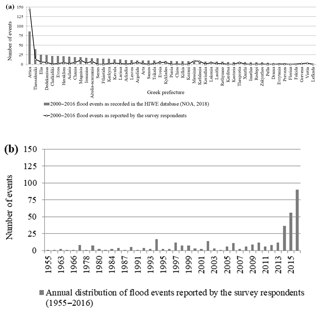
Figure 2(a) Number of flood events per Greek prefecture in the period 2000–2016, as recorded in the HIWE database (NOA, 2019; Papagiannaki et al., 2013) and the survey. (b) Annual distribution of the survey flood reports (1955–2016).
To assess the objectivity of the respondents about flood experience severity, the reported flood events were identified and evaluated based on the HIWE database. Each recorded flood was then attributed to the maximum 24 h rainfall observed in the corresponding municipality where the flood event occurred. This was feasible for 281 (76 %) out of the 370 reported flood events. The correlation between the 24 h rain and the flood severity was positive and statistically significant (Spearman's rho =0.21, p < 0.001). This indicates that people more adversely affected by floods in their residential area were more likely to report a stronger flood impact. Thus, there is consistency between the rainfall hazard and the reported impact severity.
3.3 Measures
Measures for the FPB model variables were developed based on an in-depth literature review. Where necessary, the measures were adapted to better reflect the concepts of the model.
3.3.1 Current preparedness
Various indicators have been used in recent literature to measure individual preparedness across different regions. Bradford et al. (2012) measured the self-assessed levels of personal preparedness in six European countries with a simple Likert-scale question. Miceli et al. (2008) developed a multi-item variable to measure the extent to which households in an alpine valley in Italy implemented flood damage mitigation measures. Similarly, Poussin et al. (2014) developed different multi-item variables to measure the extent of structural, avoidance, and emergency preparedness measures implemented by the citizens of three flood-prone regions in France. In the present study, current preparedness is calculated as the sum of eight dichotomous items inquiring about the flood-preparedness measures that the respondent has currently adopted. The items are weighted for their significance in relation to the relative personal effort and the cost required for their implementation. The items and adjusted weights are reported in Table 3.
3.3.2 Preparedness intention
Preparedness intention refers to the willingness of people to make private expenses to protect themselves against future floods. Hence, it shows not only the general intention of the individual to change precautionary behavior but also the extent to which the individual is willing to realize the self-reported intention. Terpstra (2011) measured Dutch citizens' preparedness intentions, asking them questions about the extent to which they intend to take precautions. Similarly, in this study the participants were asked to indicate (on a five-point scale) the extent to which they intend to invest in precautionary measures.
3.3.3 Awareness-raising variables
Similar to Grothmann and Reusswig (2006), to measure the experience severity the participants were asked to recall their most recent flood experience and to indicate (on a five-point scale) the severity of the damage they suffered. Grothmann and Reusswig (2006) introduced the construct of threat experience appraisal in an extended version of the PMT model and found that it motivates protective responses.
Vulnerability awareness results from the synthesis of two elements related to (a) the level of perceived exposure and (b) actual exposure, meaning the hazard proximity (the distance from the closest hazardous water source). Similar to previous studies (Thieken at al., 2007), to measure the level of the perceived exposure to risk, participants were asked to rate their exposure based on objective reasons (e.g., staying in a flood-prone area suffering from frequent floods, or staying in an old/vulnerable house). To measure the actual exposure, participants were asked whether the distance to their residence is smaller or greater than 1 km. Vulnerability awareness is constructed by dividing the perceived exposure (three-point scale) by the actual exposure level (binary item).
Risk communication, although critical to enhancing flood resilience (Cardona et al., 2012), has not been adequately examined for its impact on flood preparedness. O'Sullivan et al. (2012) showed that access to information websites is related to higher flood resilience in Finland and Italy. In the present study, risk communication is measured as the sum of six dichotomous items about the means of risk communication used by local authorities to approach and inform the citizens. The communication means are weighted to account for the penetration of flood communications. In particular, it was considered that seminars on local dangers requiring the physical presence of the citizen and visualization of risks with maps and special warning signs are more effective means of communication. Alternative weights were also tested on the basis of different estimates made by colleagues with relevant experience without affecting the results of the analysis. Table 4 reports the risk communication items and adjusted weights.
3.3.4 Confidence attitudes
The construct of trust in the authorities, introduced in Terpstra (2011), was measured by two questions that rate on a five-point scale (a) the individual's confidence in the adequacy of the preventive measures taken by local authorities and (b) the individual's belief that inefficient state measures have contributed to past floods. The variable of trust included in the model is derived from the average of these two elements, the second of which was reversed as it portrays a negative attitude.
Self-confidence was measured as the average of two discrete questions about the respondent's perception of being aware (a) of local flood hazards and (b) of the existing protection measures. Thieken et al. (2007) surveyed flood preparedness in Germany and introduced the constructs of perceived knowledge about the flood hazard of the residence and perceived knowledge about self-protection.
3.3.5 Risk perception and worry
Risk perception has been defined as the subjective assessment of the likelihood of occurrence of a particular type of accident and of the severity of the potential consequences (Sjöberg et al., 2004). Miceli et al. (2008) suggested combining these two elements of risk perception into an overall, more comprehensive indicator. Following this concept, a single variable was included in the preparedness model. Table 5 reports the specific questions used for the synthesis of risk perception. The reliability of the risk perception indicator is high (Cronbach's alpha =0.88) according to recommended thresholds (Tavakol and Dennick, 2011). Worry was measured by a question about how concerned the respondent feels about a possible future flood event. We find the same approach in Bradford et al. (2012) and Zaalberg et al. (2009).
3.3.6 Demographics
Home ownership and gender are codified as dichotomous variables. Family size and employment status are codified as ordinal variables (Table 2) and age is a continuous variable. To measure the degree of urbanization, the survey participants were asked to characterize their settlement based upon urbanization criteria (cottage area, village, small town, or city).
Table 6 presents descriptive statistics and correlations between the model variables. We employed the nonparametric Spearman's rank correlation method, which does not assume normality of data and is appropriate for correlating both continuous and discrete variables (McDonald, 2014; Shipley, 2016). None of the correlations are high enough (Spearman's rho < 0.40) to raise any concerns for the subsequent analysis (Gujarati, 2004).
Table 6Descriptive statistics and correlations (Spearman's rank coefficient, rho).
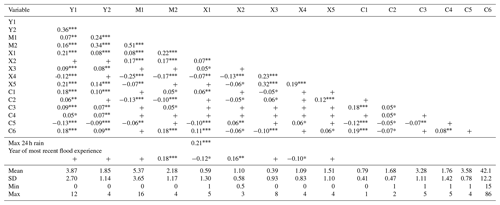
Y1: current preparedness; Y2: preparedness intention; M1: risk perception; M2: worry; X1: experience severity; X2: vulnerability awareness; X3: risk communication; X4: trust in authorities; X5: self-confidence; C1: ownership; C2: gender; C3: family size; C4: employment; C5: urbanization; C6: age. The sample size (n) in the correlations between pairs of variables is 1810, except for the correlations with “age” (n=1227), “year of most recent flood experience” (n=368), and “max 24 h rain” (n=281). The “max 24 h rain” is the maximum 24 h rain accumulated during the flood events reported by the survey respondents. Statistical significance, p value, is symbolized as +p > 0.05 (not significant): *p ≤ 0.05, p < 0.01, p < 0.001.
3.4 Statistical method
Path analysis, a structural equation modeling (SEM) methodology (Hayes, 2013), was applied to test the FPB model hypotheses. The use of SEM allows for a simultaneous evaluation of the relationships in a hypothesized mediation process, the direct effect of the predictor variable on the outcome, and the mediation effect explaining how an exogenous variable affects the outcome variable through the mediator (Iacobucci, 2010). The amount of mediation is called the indirect effect. Mediation effect can be classified as full mediation and partial mediation. Full mediation is reported when predictor variable X does not have a direct significant impact on response variable Y, but it has a significant effect on moderator M, which also has a significant effect on outcome variable Y. In partial mediation the difference is that predictor variable X has both a direct and an indirect effect on outcome variable Y.
SEM produces parameters that indicate the nature and size of the relationship between the model variables, and information about the overall fit of the model. To address possible interdependence that could bias the path analysis results, the specification model assumes covariance between the two outcome variables (Y1 and Y2). Stata statistical software was used for all data analysis.
Note that the main specification does not include the age variable due to many missing values (34 % of the population sample). The rest of the variables had a very low number of missing values, up to 3 % of the population sample. In unreported analysis, we included age as a control variable (n=1227); age had only a marginal positive effect on current preparedness (SEM standardized coefficient 0.02, SE =0.01, p < 0.05), while the effect on preparedness intention was statistically insignificant (p > 0.05). The results remained qualitatively the same.
Table 7 includes the path analysis results. The direct and indirect effects' size is estimated using the standardized SEM coefficients. A p value of 5 % or lower is considered to be statistically significant. To assess the model validity, we report multiple fit indices (Marsh et al., 2004; Iacobucci, 2010). The comparative fit index (CFI) was above the threshold of 0.9 and both the standardized root-mean-square residual (SRMR) and the root-mean-square error of approximation (RMSEA) fit indices were below the threshold of 0.10. These results indicate a very good fit of the data (Hu and Bentler, 1999; Iacobucci, 2010).
Table 7Path analysis results and fit statistics.
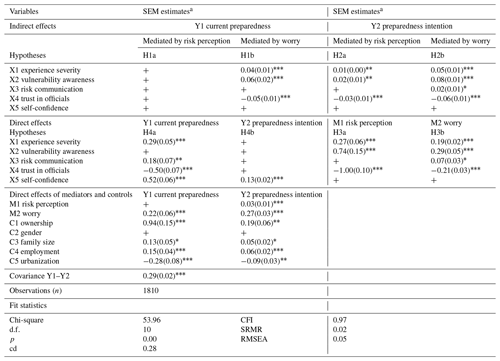
Note. Statistical significance, p value, is symbolized as +p > 0.05 (not significant), *p ≤ 0.05, p < 0.01, p < 0.001. a The SEM (structural equation modeling) estimates are standardized coefficients with standard errors in parentheses.
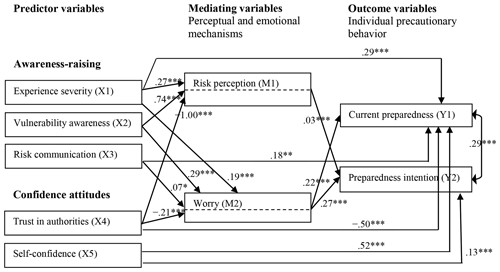
Figure 3FPB model path analysis results. (1) Only the statistically significant direct effects (SEM standardized coefficients) are reported. (2) n=1810. (3) , , ∗p < 0.05. (3) Indirect (mediated) effects are reported in Table 7 and explained in the Results section. Dashed lines indicate the mediation paths.
To facilitate interpretation of the mediating role of risk perception and worry, Fig. 3 shows the direct and indirect effects (standardized SEM coefficients) of predictor variables (X1–X5) on current preparedness Y1 (Fig. 3a) and preparedness intention Y2 (Fig. 3b). The overall indirect effect is divided into the mediated effects attributed to risk perception and worry. The sum of the direct and the indirect effects equals the total effect of the predictor on the outcome variable.
4.1 Mediation effects
Path analysis results (Table 7) suggest that risk perception does not mediate the effects of the awareness-raising and confidence variables upon current preparedness (H1a). Risk perception, however, was found to mediate the effects of three predictor variables, namely experience severity (0.01, p < 0.01), vulnerability awareness (0.02, p < 0.01), and trust in authorities (−0.03, p < 0.001), on preparedness intention (H1b). As expected, indirect effects on preparedness intention due to the mediation of risk perception were found positive for experience severity and vulnerability awareness and negative for trust in authorities.
-
Hypothesis H1a is not confirmed.
-
Hypothesis H1b is partly confirmed. Mediation effects on Y2 due to M1 are statistically significant for three predictor variables (X1, X2, and X4).
With regard to the emotional process, results indicate that worry mediates the effects of experience severity upon current preparedness (0.04, p < 0.001) and preparedness intention (0.05, p < 0.001). Worry was also found to fully mediate (i.e., no direct effect of the predictor on the outcome was found) the effect of vulnerability awareness on current preparedness (0.06, p < 0.001) and the largest part of the mediated effect on preparedness intention (0.08, p < 0.001). The effect of risk communication on preparedness intention was fully mediated by feelings of worry (0.02, p≤0.05). In contrast, risk communication appeared to have only a direct effect on current preparedness without the interference of emotional process. As presumed, worry was found to mediate the effect that trust in authorities has on precautionary behavior. The effect was negative on both the current preparedness (−0.05, p < 0.001) and preparedness intention (−0.06, p < 0.001). Moreover, the effect of trust in authorities on preparedness intention was fully mediated by the emotional process. Finally, worry was not found to mediate any of the effects of self-confidence on the two precautionary behaviors. The above findings provide partial support of hypotheses H2a and H2b.
-
Hypothesis H2a is partly confirmed. Mediation effects on Y1 due to M2 are statistically significant for three predictor variables (X1, X2, and X4).
-
Hypothesis H2b is partly confirmed. Mediation effects on Y2 due to M2 are statistically significant for four predictor variables (X1, X2, X3, and X4).
4.2 Direct effects
Path modeling results, in particular the direct effects (standardized SEM coefficients), are illustrated in Fig. 4. Results supported most of the predicted direct effects of predictor variables on risk perception (H3a). Specifically, the effects of experience severity (0.27, p < 0.001), vulnerability awareness (0.74, p < 0.001), and trust in authorities (−1.00, p < 0.001) were statistically significant. The SEM parameter estimates for the paths between risk communication or self-confidence and risk perception were not statistically significant. With respect to the impact of predictor variables on worry (H3b), the effects of experience severity (0.19, p < 0.001), vulnerability awareness (0.29, p < 0.001), risk communication (0.07, p < 0.05), and trust in authorities (−0.21, p < 0.001) were statistically significant. The results show a non-significant estimate (p > 0.05) for the effect of self-confidence on worry.
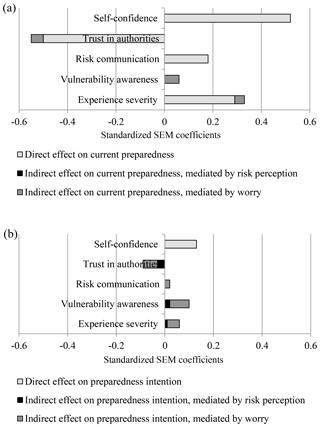
Figure 4Total effects (SEM standardized coefficients) of the FPB model's predictor variables on the current preparedness (a) and the preparedness intention (b). Each total effect is further analyzed as direct effects and indirect effects mediated by risk perception and worry.
-
Hypothesis H3a is partly confirmed. Direct effects on M1 are statistically significant for three predictor variables (X1, X2, and X4).
-
Hypothesis H3b is partly confirmed. Direct effects on M2 are statistically significant for four predictor variables (X1, X2, X3, and X4).
Results indicated that predictor variables apart from vulnerability awareness have a direct impact on current preparedness (H4a). As expected, greater experience severity (0.29, p < 0.001), risk communication (0.18, p < 0.001), and self-confidence (0.52, p < 0.001) were found to positively affect current preparedness, while greater trust in authorities was found to have a negative effect (−0.50, p < 0.001). Overall, results did not support the predicted direct effects of predictors on preparedness intention, with the exception of self-confidence that was found to have a positive direct effect (0.13, p < 0.001).
-
Hypothesis H4a is partly confirmed. Direct effects on Y1 are statistically significant for four predictor variables (X1, X3, X4, and X5).
-
Hypothesis H4b is partly confirmed. Direct effects on Y2 are statistically significant only for one predictor variable (X5).
4.3 Correlation between current preparedness and preparedness intention
Path analysis detected a positive covariance between current preparedness (Y1) and preparedness intention (Y2) (0.29, p < 0.001). Moreover, the Spearman's rank correlation analysis showed a positive and significant correlation between Y1 and Y2 (Table 6). Further correlation analyses also indicated the strong relationship between Y1 and Y2 among the respondents with prior flood experience. Specifically, the Spearman's rho between Y1 and Y2 was 0.40 (p < 0.001) for the population sample with flood experience and 0.44 (p < 0.001) if the experience severity was over 3 (on a scale from 0 to 5). To further investigate the nature and significance of the Y1–Y2 relationship, we assessed the correlations between Y2 and each of the items that compose Y1 (Table 3). The Spearman's rho varied from 0.11 to 0.27 (p < 0.001) if the precautionary measure referred to investing money for simple flood-defense measures, for insurance, or for structural changes. The correlations were also positive when accounting for the application of uncostly measures (from 0.13 to 0.23, p < 0.001). In contrast, the correlations between Y2 and the “no adaptation” items (Table 3, items 7–8) were negative (from −0.14 to −0.21, p < 0.001). These analyses support the model results with regard to the statistically positive correlation between Y1 and Y2. Table 8 reports the average score of preparedness intention among the respondents who applied and the ones who did not apply precautionary measures, depending on the cost level needed for the implementation.
Table 8Average preparedness intention between the respondents who applied and the ones who did not apply flood-precautionary measures.

1 Y2 coded as 0 “no intention” to 4 “very strong intention”. 2 SE refers to standard error and N to observations in parentheses. 3 Respondents that did not apply any measure demonstrate lower average preparedness intention.
4.4 Effects of demographics
Overall, the control variables performed as expected. They were found to influence preparedness, as presumed, except for gender. We should note that prior studies largely question the effect of gender on precautionary behavior (Wachinger et al., 2013). In contrast, home ownership and unemployment, the rates of which in the present survey are representative of the census data, have been associated with precautionary behavior (Burningham et al., 2008). Home ownership (C1) had the largest positive effect on current preparedness (0.94, p < 0.001), as well as on preparedness intention (0.19, p < 0.001). Employment status, on a scale of 1 for unemployed to 5 for currently employed respondents (Table 2), was found to have a positive effect on both current preparedness (0.15, p < 0.001) and preparedness intention (0.06, p < 0.001). Family size was also found to be related to precautionary behavior. This finding is consistent with the results found in the literature by Diakakis et al. (2018) and Zaalberg et al. (2009). Specifically, greater family size is related to higher levels of current preparedness (0.13, p≤0.05) and preparedness intention (0.05, p≤0.05). Higher urbanization, conversely, was found to be related to reduced current preparedness (−0.28, p < 0.001) and preparedness intention (−0.09, p < 0.01), in line with the findings of Scolobig et al. (2012).
5.1 Theoretical implications
The primary objective of this study was to advance understanding of the mechanisms that link awareness-raising and confidence-related variables with current flood preparedness and with preparedness intention. The secondary objective of the study was to investigate the relationship between the existing degree of preparedness and the intention to invest in more measures. Hence, the findings may help researchers to build more comprehensive models that would better predict flood-risk precautionary behavior.
5.1.1 Perceptual and emotional mechanisms of preparedness
Overall, the results supported the hypothesis that perceptual and emotional processes constitute mechanisms driving flood-risk precautionary behavior. The emotional mediating process is stronger when compared to the perceptual one. The majority of the preparedness predictors are stimulated by feelings of worry about a flood event. Risk perception at the time of the survey is associated only with preparedness intention. Thus, risk perception does not answer why awareness and confidence have triggered the existing level of preparedness. However, it is likely that past risk perceptions might have affected prior preparedness motivations, associated with what we call “current preparedness”. Prior experiences and a broad framework of past references might have influenced the perception of risk over time. A possible time-dependent relationship between risk perception and precautionary behavior could partly be the answer to the concerns raised about the paradox that high risk perception does not necessarily lead to higher preparedness or that it may even lead to lower preparedness (Siegrist and Gutscher, 2008; Wachinger et al., 2013). A longitudinal study could therefore provide more evidence on the impact of risk perception on individual precautionary behavior.
Both risk perception and worry appear to trigger preparedness intention in the presence of an environment that increases citizens' awareness of flood-related issues and decreases confidence in the authorities' coping capacities. The latter is in agreement with the findings of Wachinger et al. (2013) regarding the negative impact of trust on the perception of the likelihood and magnitude of floods and hence the willingness to take private measures. The severity of a prior flood experience and how it relates to precautionary behavior is also associated with the stimulation of flood-risk perception and feelings of worry. With regard to worry, the finding is in line with those of Siegrist and Gutscher (2008), who suggested that flood victims might have taken more precautionary measures than citizens without flood experience, due to negative emotions.
Together worry and risk perception were found to fully mediate the impact of all the examined predictors on preparedness intention, with the exception of self-confidence. An earlier severe experience, awareness of flood-vulnerability and targeted risk communication may thus motivate people to take precautions due to the intervention of perceptual and emotional mechanisms. In addition, the fact that higher trust in authorities was found to reduce preparedness intention is fully explained by the examined mechanisms. Higher trust is shown to relate to decreased worry, in line with Terpstra's findings (2011), as well as to decreased flood-risk perception. As literature has pointed out, trust brings security feelings and thus may be an important cause of the reluctance of citizens to take precautionary measures (Poussin et al., 2014).
The only variable not filtered by either risk perception or worry is self-confidence, which appears to have only direct impact on precautionary behaviors. The more confident a person feels about knowing the local flood hazards and the available protective measures, the higher the level of current preparedness and the intention to adopt precautionary behavior. We should note that results about the mediating emotional and perceptual processes that lead to preparedness cannot easily be compared to previous findings, as the recent literature has focused on the direct relationships between the factors relating to individual precautionary behaviors. However, our empirical findings support the theoretical argumentation about the regulating role of emotions in the relationship between the individual and the environment (Miceli et al., 2008). The role of emotion has been treated with caution in the PMT. Rogers (1975) supported that the cognitive processes may better explain the effects of fear-appeal components on attitude change. Our findings show that risk perception, as a cognitive process, may indeed stimulate the intention of the individual to adopt flood precautionary behavior.
5.1.2 The link between current preparedness and preparedness intention
An interesting finding of the study is the positive correlation of current preparedness and preparedness intention that may seem paradoxical at first glance. Why do citizens that are currently more prepared appear to be more willing to invest in future precautionary measures? On the basis of further analyses discussed in the previous section, we argue that people may acknowledge the benefits of precautionary measures previously implemented. Furthermore, citizens who are already well informed and familiar with implementing measures probably feel more willing to repeat this behavior. We should also take into account that flood precaution is not a one-off action. Precautionary measures may need refreshment over time. Our analysis indicates that people evaluate the final benefit independent of the resources needed for a protection measure. As shown, citizens are prepared to further invest in protective measures even if they have already invested in high-cost measures. Conversely, those who have not yet taken private measures are more likely not to be willing to change their attitude in the near future.
We also acknowledge that there may be uncertainty regarding the actual behavior that will follow one's intention to adopt precautionary behavior, as argued by Schifter and Ajzen (1985). That is, people may declare willingness simply because they know that is the right thing to do. However, the online survey has the advantage that it protects respondent anonymity, while it removes the presence of the judge–researcher. Hence, it allows for objective rather than “satisfactory” answers and reduces potential social desirability bias (Podsakoff et al., 2003). Nevertheless, the concluding remark is that the relationship between the two preparedness variables is not straightforward. Variables that could intervene in this relationship might be the self-estimated effectiveness of the previously applied measures, the usefulness of each of these measures based on previous flood experience, and the assessment of the cost-saving the individual achieved. In addition, further questions to evaluate the “actual” intention of the respondent could be included in a future survey.
5.2 Practical implications
Results show a poor performance of current preparedness and a modest performance of preparedness intention. Individual preparedness among the flood-affected respondents is higher, but again the average performance is marginally close to the average level, which is 5 for the current preparedness (max =12) and 2 for the preparedness intention (max =4). This indicates that there is significant potential for improvement of the overall preparedness of citizens, with support from the local authorities.
Moreover, the profile of the survey participants shows that Greek people tend to perceive low risk from flooding but not due to ignorance. In fact, the path analysis does not demonstrate an association between risk communication and risk perception. As Brown (2014) points out, risk perception draws on much more than facts alone. Indeed, the results show that risk perception is associated with vulnerability awareness. People who more accurately appreciate their exposure to flood risk may perform higher risk perception.
Collective findings from the present study could inform policy makers on specific options that they could support to improve flood-risk management at the local level. These options are related to both raising public awareness and establishing the right relationship between citizens and local authorities. As the results show, the effectiveness of these options will be significantly affected by individuals' perception and emotions against flood risk. A successful campaign should therefore include the promotion of information on the level of citizens' exposure to risk at the local level on the basis of objective risks and lessons learned from past flood events. This will lead to increased awareness and activation of citizens due to increased concern and flood-risk perception.
Investment in the effective communication of local flood hazards and risks should be local authorities' priority. The analysis of the survey participants' profiles shows that Greek citizens are not effectively approached by flood-risk managers; the vast majority of citizens never received any information about local flood hazards from the local authorities. This indicates a noticeable gap in the risk communication process or a highly inefficient top-down risk management. Both cases may constitute significant weaknesses of Greek communities' resilience to floods. The high frequency of catastrophic flood events due to rainfall has already been demonstrated in a previous study targeting Greece (Papagiannaki et al., 2013). In addition, recent studies of the individual flood emergency responses in Attica found a low degree of individual response to flood alerts, limited knowledge of flood risks and ineffectiveness of risk communication as well as low trust in authorities (Diakakis et al., 2018; Papagiannaki et al., 2017).
According to the survey results, people in more urbanized areas are manifesting higher trust in authorities and lower vulnerability awareness. Moreover, the urban environment is associated with reduced flood precautionary behavior. These findings indicate a high dependency of urban citizens on local authorities, which in turn may conceal complacency against flood risk. Therefore, policy makers should clearly reach the public audience with the message that building resilience against flood risk at the community level needs the involvement of the citizens. Results also indicated that people owning a home are more likely to be already prepared to a certain extent, as well as to be willing to invest in more measures. Therefore, especially in the case of property owners, a successful measure could be to provide financial incentives for the implementation of protective measures. For example, Poussin et al. (2014) showed that both homeownership and incentives from insurers increase the likelihood of French citizens implementing flood-risk mitigation measures.
This study examined the hypotheses that risk perception and worry mediate the effects of awareness-raising and confidence-related variables on individual precautionary behaviors against flood risk. The methodological approach meant to integrate key explanatory variables within a model that focused on important mechanisms of self-protective behavior. In this context, we further analyzed the association between the current flood preparedness and preparedness intention to provide an overview of behavior modifications. The most important conclusions can be summarized as follows.
-
The proposed model in this paper showed that risk perception and worry constitute mechanisms of the individual's flood-risk precautionary behavior. In particular, together worry and risk perception explain how awareness-raising variables and trust affect citizens' intention to invest in precautionary measures.
-
Worry was demonstrated to stimulate both the citizens' current preparedness and preparedness intention. Conversely, risk perception failed to explain the existing level of preparedness. The possibility that past risk perceptions may have affected prior preparedness motivations, associated with what we call current preparedness needs to be further investigated.
-
Interestingly, current preparedness and preparedness intention were found to have a positive relationship. Citizens who have undertaken preparedness measures in the past appear to be more willing to invest in new measures, probably motivated by the benefits they gained from the efforts to protect themselves in the past.
-
All the awareness and confidence variables included in the model were found to influence flood precautionary behaviors. Policy makers could benefit from these findings in designing more effective flood-risk mitigation strategies. Engaging citizens in their efforts to increase resilience of communities to floods can be of great value.
-
To conclude, the present study extends current knowledge of the drivers of citizens' flood precautionary behavior. The research findings could help researchers to build more comprehensive models of flood-risk precautionary behavior; they could also become useful material for the local authorities.
The online questionnaire is available in the Supplement to this article. The complete data set can be shared only in the context of scientific cooperation as it is intended to be used in post-survey analyses.
The supplement related to this article is available online at: https://doi.org/10.5194/nhess-19-1329-2019-supplement.
The research presented in the current publication was designed and coordinated by KL, VK, and KP. The lead author, KP, designed the questionnaire, processed the data set, and developed the FPB model. GP provided statistical expertise for data analyses and contributed to SEM modeling.
The authors declare that they have no conflict of interest.
This research has been financed by the “Development Proposals of Research Entities – KRIPIS II” framework, which is funded by National Program “Competitiveness and Entrepreneurship 2014–2020”, action “THESPIA II – Development of synergistic and integrated methods and tools for monitoring, management and forecasting of environmental parameters and pressures”. It is also a contribution to the HYdrological cycle in the Mediterranean EXperiment (HYMEX) program.
This research has been supported by the National Project Competitiveness and Entrepreneurship 2014–2020 action “THESPIA II – Development of synergistic and integrated methods and tools for monitoring, management and forecasting of environmental parameters and pressures” (MIS 5002517).
This paper was edited by Sven Fuchs and reviewed by two anonymous referees.
Barredo, J. I.: Major flood disasters in Europe: 1950–2005, Nat. Hazards, 42, 125–148, https://doi.org/10.1007/s11069-006-9065-2, 2007.
Barredo, J. I.: Normalised flood losses in Europe: 1970–2006, Nat. Hazards Earth Syst. Sci., 9, 97–104, https://doi.org/10.5194/nhess-9-97-2009, 2009.
Botzen, W. J. W., Aerts, J. C. J. H., and van den Bergh, J. C. J. M.: Willingness of homeowners to mitigate climate risk through insurance, Ecol. Econ., 68, 2265–2277, https://doi.org/10.1016/j.ecolecon.2009.02.019, 2009.
Bradford, R. A., O'Sullivan, J. J., van der Craats, I. M., Krywkow, J., Rotko, P., Aaltonen, J., Bonaiuto, M., De Dominicis, S., Waylen, K., and Schelfaut, K.: Risk perception – issues for flood management in Europe, Nat. Hazards Earth Syst. Sci., 12, 2299–2309, https://doi.org/10.5194/nhess-12-2299-2012, 2012.
Brown, V. J.: Risk Perception: It's personal, Environ. Health Persp., 122, A276–A279, https://doi.org/10.1289/ehp.122-A276, 2014.
Bubeck, P., Botzen, W. J. W., and Aerts, J. C. J. H.: A review of risk rerceptions and other factors that influence flood mitigation behavior, Risk Anal., 32, 1481–1495, https://doi.org/10.1111/j.1539-6924.2011.01783.x, 2012.
Burningham, K., Fielding, J., and Thrush, D.: “It'll never happen to me”: understanding public awareness of local flood risk, Disasters, 32, 216–238, https://doi.org/10.1111/j.1467-7717.2007.01036.x, 2008.
Cardona, O. D., van Aalst, M. K., Birkmann, J., Fordham, M., McGregor, G., Perez, R., Pulwarty, R. S., Schipper, E. L. F., and Sinh, B. T. (Eds.): Determinants of risk: exposure and vulnerability, in: Managing the risks of extreme events and disasters to advance climate change adaptation, A Special Report of Working Groups I and II of the Intergovernmental Panel on Climate Change (IPCC), 65–108, Cambridge, UK, and New York, NY, USA, Cambridge University Press, 2012.
Diakakis, M., Priskos, G., and Skordoulis, M.: Public perception of flood risk in flash flood prone areas of Eastern Mediterranean: The case of Attica Region in Greece, Int. J. Disast. Risk Re., 28, 404–413, doi.org/10.1016/j.ijdrr.2018.03.018, 2018.
EC (European Civil Protection and Humanitarian Aid Operations): Disaster preparedness, available at: https://ec.europa.eu/echo/what/humanitarian-aid/disaster_preparedness_en, last access: 18 June 2019.
Fatti, C. E. and Patel, Z.: Perceptions and responses to urban flood risk: Implications for climate governance in the South, Appl. Geogr., 36, 13–22, https://doi.org/10.1016/j.apgeog.2012.06.011, 2013.
Glatron, S. and Beck, E.: Evaluation of socio-spatial vulnerability of citydwellers and analysis of risk perception: industrial and seismic risks in Mulhouse, Nat. Hazards Earth Syst. Sci., 8, 1029–1040, https://doi.org/10.5194/nhess-8-1029-2008, 2008.
Grothmann, T. and Reusswig, F.: People at risk of flooding: why some residents take precautionary action while others do not, Nat. Hazards, 38, 101–120, 2006.
Gujarati, D. N.: Basic econometrics, 4th ed., USA, New York, NY, The McGraw-Hill Companies, 2004.
Hayes, A. F.: Introduction to mediation, moderation, and conditional process analysis: A regression-based approach, New York, NY, Guilford Publications, 2013.
Hu, L.-T. and Bentler, P. M.: Cutoff criteria for fit indexes in covariance structure analysis: Conventional criteria versus new alternatives, Struct. Equ. Modeling, 6, 1–55, https://doi.org/10.1080/10705519909540118, 1999.
Iacobucci, D.: Structural equations modeling: Fit Indices, sample size, and advanced topics, J. Consum. Psychol., 20, 90–98, https://doi.org/10.1016/j.jcps.2009.09.003, 2010.
Kellens, W., Zaalberg, R., Neutens, T., Vanneuville, W., and De Maeyer, P.: An analysis of the public perception of flood risk on the belgian coast, Risk Anal., 31, 1055–1068, https://doi.org/10.1111/j.1539-6924.2010.01571.x, 2011.
Kellens, W., Terpstra, T., and De Maeyer, P.: Perception and communication of flood risks: A systematic review of empirical research, Risk Anal., 33, 24–49, https://doi.org/10.1111/j.1539-6924.2012.01844.x, 2013.
Kreibich, H. and Thieken, A. H.: Coping with floods in the city of Dresden, Germany, Nat. Hazards, 51, 423, https://doi.org/10.1007/s11069-007-9200-8, 2008.
Kron, W.: Flood risk = hazard ⋅ values ⋅ vulnerability, Water Int., 30, 58–68, https://doi.org/10.1080/02508060508691837, 2005.
Lagouvardos, K., Kotroni, V., Koussis, A., Feidas, H., Buzzi, A., and Malguzzi, P.: The meteorological model BOLAM at the National Observatory of Athens: Assessment of two-year operational use, J. Appl. Meteorol., 42, 1667–1678, https://doi.org/10.1175/1520-0450(2003)042<1667:tmmbat>2.0.co;2, 2003.
Lagouvardos, K., Kotroni, V., Bezes, A., Koletsis, I., Kopania, T., Lykoudis, S., Mazarakis, N., Papagiannaki, K., and Vougioukas, S.: The automatic weather stations NOANN network of the National Observatory of Athens: operation and database, Geosci. Data J., 4, 4–16, https://doi.org/10.1002/gdj3.44, 2017.
Lave, T. R. and Lave, L. B.: Public perception of the risks of floods: Implications for communication, Risk Anal., 11, 255–267, https://doi.org/10.1111/j.1539-6924.1991.tb00602.x, 1991.
Marsh, H. W., Hau, K.-T., and Wen, Z.: In search of golden rules: Comment on hypothesis-testing approaches to setting cutoff values for fit indexes and dangers in overgeneralizing Hu and Bentler's (1999) findings, Struct. Equ. Modeling, 11, 320–341, https://doi.org/10.1207/s15328007sem1103_2, 2004.
McDonald, J. H.: Handbook of Biological Statistics, 3rd ed., Sparky House Publishing, Baltimore, Maryland, available at: http://www.biostathandbook.com/ (last access: 18 June 2019), 2014.
Miceli, R., Sotgiu, I., and Settanni, M.: Disaster preparedness and perception of flood risk: A study in an alpine valley in Italy, J. Environ. Psychol., 28, 164–173, https://doi.org/10.1016/j.jenvp.2007.10.006, 2008.
NOA (High-impact weather events (HIWE) interactive database): Weather events with socio-economic impact in Greece, since 2001, National Observatory of Athens, Institute for Environmental Research and Sustainable Development, Weather forecast group, available at: http://www.meteo.gr/weather_cases.cfm (last access: 18 June 2019), 2019
Nye, M., Tapsell, S., and Twigger-Ross, C.: New social directions in UK flood risk management: moving towards flood risk citizenship?, J. Flood Risk Manag., 4, 288–297, https://doi.org/10.1111/j.1753-318X.2011.01114.x, 2011.
O'Neill, E., Brereton, F., Shahumyan, H., and Clinch, J. P.: The impact of perceived flood exposure on flood-risk perception: The role of distance, Risk Anal., 36, 2158–2186, https://doi.org/10.1111/risa.12597, 2016.
O'Sullivan, J. J., Bradford, R. A., Bonaiuto, M., De Dominicis, S., Rotko, P., Aaltonen, J., Waylen, K., and Langan, S. J.: Enhancing flood resilience through improved risk communications, Nat. Hazards Earth Syst. Sci., 12, 2271–2282, https://doi.org/10.5194/nhess-12-2271-2012, 2012.
Papagiannaki, K., Lagouvardos, K., and Kotroni, V.: A database of high-impact weather events in Greece: a descriptive impact analysis for the period 2001–2011, Nat. Hazards Earth Syst. Sci., 13, 727–736, https://doi.org/10.5194/nhess-13-727-2013, 2013.
Papagiannaki, K., Kotroni, V., Lagouvardos, K., Ruin, I., and Bezes, A.: Urban area response to flash flood–triggering rainfall, featuring human behavioral factors: The case of 22 October 2015 in Attica, Greece, Weather Clim. Soc., 9, 621–638, https://doi.org/10.1175/wcas-d-16-0068.1, 2017.
Podsakoff, P. M., MacKenzie, S. B., Lee, J. Y., and Podsakoff, N. P.: Common method biases in behavioral research: A critical review of the literature and recommended remedies, J. Appl. Psychol., 88, 879–903, https://doi.org/10.1037/0021-9010.88.5.879, 2003.
Poussin, J. K., Botzen, W. J. W., and Aerts, J. C. J. H.: Factors of influence on flood damage mitigation behaviour by households, Environ. Sci. Policy, 40, 69–77, https://doi.org/10.1016/j.envsci.2014.01.013, 2014.
Raaijmakers, R., Krywkow, J., and van der Veen, A.: Flood risk perceptions and spatial multi-criteria analysis: an exploratory research for hazard mitigation, Nat. Hazards, 46, 307–322, https://doi.org/10.1007/s11069-007-9189-z, 2008.
Rambonilaza, T., Joalland, O., and Brahic, E.: Landowner's perception of flood risk and preventive actions in estuarine environment: An empirical investigation, J. Environ. Manage., 180, 272–279, https://doi.org/10.1016/j.jenvman.2016.05.037, 2016.
Rogers, R. W.: A protection motivation theory of fear appeals and attitude change, The Journal of Psychology, 91, 93–114, https://doi.org/10.1080/00223980.1975.9915803, 1975.
Rogers, R. W.: Cognitive and physiological processes in fear appeals and attitude change: A revised theory of protection motivation, in: Social psychophysiology, edited by: Cacioppo, J. and Petty, R., New York, NY, Guilford Press, 1983.
Ruin, I., Gaillard, J.-C., and Lutoff, C.: How to get there? Assessing motorists' flash flood risk perception on daily itineraries, Environ. Hazards, 7, 235–244, https://doi.org/10.1016/j.envhaz.2007.07.005, 2007.
Schifter, D. E. and Ajzen, I.: Intention, perceived control, and weight loss: An application of the theory of planned behavior, J. Pers. Soc. Psychol., 49, 843–851, 1985.
Scolobig, A., De Marchi, B., and Borga, M.: The missing link between flood risk awareness and preparedness: findings from case studies in an Alpine Region, Nat. Hazards, 63, 499–520, https://doi.org/10.1007/s11069-012-0161-1, 2012.
Shipley, B.: Path analysis and maximum likelihood, In Cause and Correlation in Biology: A User's Guide to Path Analysis, Structural Equations and Causal Inference with R, 87–125, Cambridge, Cambridge University Press, https://doi.org/10.1017/CBO9781139979573.006, 2016.
Siegrist, M. and Gutscher, H.: Natural hazards and motivation for mitigation behavior: People cannot predict the affect evoked by a severe flood, Risk Anal., 28, 771–778, https://doi.org/10.1111/j.1539-6924.2008.01049.x, 2008.
Sjöberg, L., Moen, B.-E., and Rundmo, T.: Explaining risk perception, An evaluation of the psychometric paradigm in risk perception, Trondheim, Norway, Norwegian University of Science and Technology, Department of Psychology, C Rotunde Publikasjoner, available at: http://www.svt.ntnu.no/psy/Torbjorn.Rundmo/Psychometric_paradigm.pdf (last access: 18 June 2019), 2004.
Takao, K., Motoyoshi, T., Sato, T., and Fukuzono, T.: Factors determining residents' preparedness for floods in modern megalopolises: The case of the Tokai flood disaster in Japan, J. Risk Res., 7, 775–787, 2004.
Tavakol, M. and Dennick, R.: Making sense of Cronbach's alpha, International Journal of Medical Education, 2, 53–55, https://doi.org/10.5116/ijme.4dfb.8dfd, 2011.
Terpstra, T.: Emotions, trust, and perceived risk: affective and cognitive routes to flood preparedness behavior, Risk Anal., 31, 1658–1675, https://doi.org/10.1111/j.1539-6924.2011.01616.x, 2011.
Terpstra, T. and Lindell, M. K.: Citizens' perceptions of flood hazard adjustments, Environ. Behav., 45, 993–1018, https://doi.org/10.1177/0013916512452427, 2013.
Terti, G., Ruin, I., Anquetin, S., and Gourley, J.: Dynamic vulnerability factors for impact-based flash flood prediction, Nat. Hazards, 79, 1481–1497, https://doi.org/10.1007/s11069-015-1910-8, 2015.
Thieken, A. H., Petrow, T., Kreibich, H., and Merz, B.: Insurability and Mitigation of Flood Losses in Private Households in Germany, Risk Anal., 26, 383–395, https://doi.org/10.1111/j.1539-6924.2006.00741.x, 2006.
Thieken, A. H., Kreibich, H., Müller, M., and Merz, B.: Coping with floods: preparedness, response and recovery of flood-affected residents in Germany in 2002, Hydrolog. Sci. J., 52, 1016–1037, https://doi.org/10.1623/hysj.52.5.1016, 2007.
Treby, E. J., Clark, M. J., and Priest, S. J.: Confronting flood risk: Implications for insurance and risk transfer, J. Environ. Manage., 81, 351–359, https://doi.org/10.1016/j.jenvman.2005.11.010, 2006.
UN/ISDR (United Nations Terminology): Terminology on disaster risk reduction, available at: https://www.unisdr.org/we/inform/terminology (last access: 18 June 2019), 2009.
Wachinger, G., Renn, O., Begg, C., and Kuhlicke, C.: The risk perception paradox – Implications for governance and communication of natural hazards: Risk Anal., 33, 1049–1065, https://doi.org/10.1111/j.1539-6924.2012.01942.x, 2013.
Zaalberg, R., Midden, C., Meijnders, A., and McCalley, T.: Prevention, adaptation, and threat denial: Flooding experiences in the Netherlands, Risk Anal., 29, 1759–1778, https://doi.org/10.1111/j.1539-6924.2009.01316.x, 2009.






